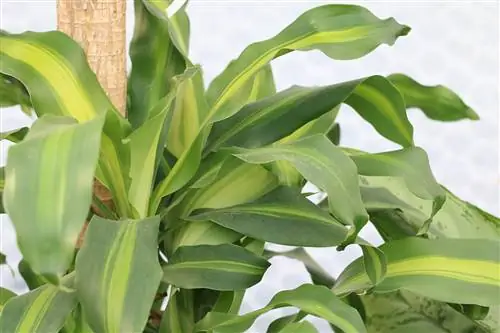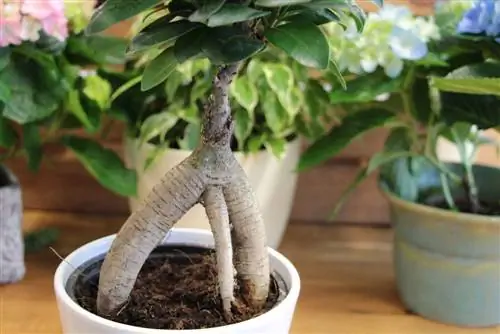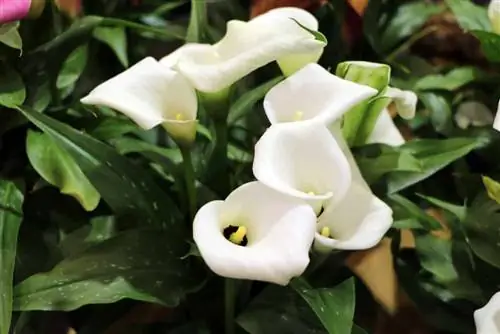- Author admin [email protected].
- Public 2023-12-17 03:39.
- Last modified 2025-06-01 06:48.
Living spaces designed to be close to nature form the alternative to the hectic pace of everyday life in modern times. They only become an oasis of peace and comfort when green and flowering plants exert their powerful aura on the human psyche. On the one hand, they serve as a stylistic device in interior design and, on the other hand, they create a mental basis for relaxation; thanks to modern hydroponics, even without time-consuming care. Dive into the fascinating world of interior greenery with the best indoor and hydroponic plants.
Flowering houseplants
Cyclamen (Cyclamen persicum)
In countless varieties, cyclamen present a festival of colors all year round. Thanks to their growth height of up to a maximum of 25 cm, the pretty flowering plants find a place wherever it is not too sunny. So it's no surprise that they are among the most popular houseplants.
Anthurium (Anthurium scherzerianum)
With the striking yellow-orange flower heads, framed by shiny red bracts, it has an elegant appearance. If you treat it to a loving care program, you will enjoy your magnificent flamingo flower all summer long.
Azalea (Rhododendron simsii)
It impresses with an exuberant abundance of flowers. From December to April, the azalea in countless colors makes you forget the dreariness of winter. As long as it is kept in a cool, airy location and not exposed to blazing sunshine, it will do its best.
Begonia (Begonia elatior)
Immigrated from the tropics, the begonia is particularly popular as a houseplant in Germany, adorning window sills and furniture. The small flower miracle owes its name to the asymmetrical shape of its leaves. Due to its somewhat delicate water balance requirements, the begonia is considered an ideal candidate for hydroponics.
Orchid
The fascinating orchids ennoble any room with their glamorous silhouette. Among the more than 22,000 species, there is a suitable flower queen for every design wish. They can sometimes be a little capricious when it comes to care, but this fact further increases their attractiveness.
Magnificent foliage plants
Tree Friend (Philodendron erubescens)
A classic among the best houseplants comes with huge, lush green leaves. This paragon of frugality showed many a younger generation the way into hobby gardening. As a climbing plant, a philodendron transforms any room into a green refuge, as long as it is warm enough there.
Coleus(Solenostemon)
Their colorful, velvety leaves provide striking proof that a colorful plant combination does not rely on flowering plants. As long as the coleus can catch every available ray of sunshine, it will set off fireworks in bronze, purple, red and cream on the flower bench.
Dieffenbachia (Dieffenbachia)
With its marbled foliage, the Dieffenbachia sets an eye-catching accent in every room. Arranged in small groups, they offer a we alth of creative design options that awaken the interior designer in the hobby gardener. Due to their extreme toxicity, they are unfortunately not suitable for every household.
Ivy (Hedera helix)
In terms of overall planning, ivy is a hit in every room, because the evergreen climbing plant spreads the inimitable charm of simplicity. Even in the bedroom, which creates some gardening hurdles in the interior greenery, you can create pretty decorative images with ivy.
Basket Marante (Calathea)
They are at the top of the hit list of the best indoor and hydroponic plants. Basket marantes score points with numerous advantages, such as opulent leaf decoration and uncomplicated care. In addition, they fill even shady corners of the room with green vibrancy. Tip: The vast majority of all houseplants are ideal for hydroponics. An exception are bulbous plants, such as amaryllis or hyacinth, which are threatened by rot in water.
Imposing indoor palm trees
Mountain Palm (Chamaedorea)
Popular throughout Europe for easy-care interior greenery, the mountain palm offers an elegant appearance with its smooth trunk and shapely pinnate leaves. Their tolerance to dry heating air, which often represents a bottleneck for the cultivation of other indoor palms, is an advantage. In addition, it proves to be very willing to bloom, as it presents pretty flower spikes even at a young age.
Date palm - Phoenix palm (Phoenix canariensis)
It is considered a prime example of an indoor palm. The date palm impresses with a majestic crown, magnificent fronds and a deeply grained trunk. Since her care is at a beginner level, she has taken the hearts of hobby gardeners by storm. It doesn't matter much that it rarely produces the famous fruits.
Fishtail palm (Caryota mitis)
Their powerful, double-feathered fronds bring a relaxing holiday feeling to large living spaces. It boasts a multi-stemmed habit that, from a distance, is reminiscent of a small palm forest. Since the fishtail palm is quite demanding, hydroponics is particularly recommended here.
Gold Fruit Palm - Areca Palm (Dypsis lutescens)
If you're looking for an easy-care palm-shaped houseplant, you can't ignore the golden fruit palm. Feathery fronds on several decoratively ringed trunks bend distinctively towards the ground. It is primarily these mighty palm leaves that make a golden fruit palm an eye-catcher in any room.
Dwarf palm (Chamaerops humilis)
As the only palm species that comes from mainland Europe, it has a remarkably robust constitution. Its flexible attitude towards light and temperature conditions contributes significantly to its status as a popular indoor palm. Not to forget their breathtaking appearance, which is characterized by huge feathery leaves, a magnificent crown and brown, hairy trunks.
Houseplants according to Feng Shui
The design of our immediate living environment according to the Far Eastern harmony theory of Feng Shui is still on the rise in interior greenery. In addition to the visual attributes of indoor and hydroponic plants, the focus is on the harmony of all elements of the room with the human aura. Some plant species stand out in particular because they give the resident additional life energy.
Dragon Tree (Dracaena marginanta)
In its visual appearance, characterized by a slender trunk and graceful, lanceolate leaves, the dragon tree has conquered a place among the best houseplants. On a mystical level, the dragon tree has a balancing effect on humans and animals. It also creates a pleasant, vitalizing room climate in work rooms.
Green Lily (Chlorophytum comosum)
With its long, thin flower shafts and a delicate white flower, the popular houseplant often populates decorative plant stands. According to Feng Shui, it acts as an important air purifier because the spider plant binds toxins in the home. In addition, it serves as a power whisk and brings a good mood into the room.

Rubber tree (Ficus elastica)
The rubber tree has long since shed its slightly dusty image. In modern interior greenery according to Feng Shui, the evergreen foliage plant has established itself as an inspiration for creative spirits and has a balancing effect in the event of conflicts. In addition, it purifies the air and increases well-being.
Cactus - Star Cactus - Bishop's Hat (Astrophytum myriostigma)
As a representative of all cacti that are recommended as houseplants according to the Far Eastern theory of harmony, the star cactus should be mentioned here. Its task is to ward off negative energies that want to penetrate the room from outside. With their beautiful flowers, cacti don't leave anyone feeling dissatisfied. A pleasant side effect is the undemanding care that characterizes a cactus.
Elephant Foot - Bottle Tree (Beaucarnea)
With its extravagant look, the elephant's foot attracts everyone's attention, because the typical trunk thickening at the foot of the slender trunk with the enchanting tuft of leaves is unique. According to Feng Shui, the plant works wonders when it comes to displacing nervousness and grief.
Conclusion of the editors
In well-thought-out interior greenery, plants are much more than just trendy accessories. On the one hand, their appearance contributes to decoration, while at the same time they have an intensive influence on well-being. Given the overwhelming abundance of plants that thrive indoors, inspiration for selection is in great demand. The best indoor and hydroponic plants offer good guidance. Flowering and foliage plants are included, as are easy-care indoor palms. If you want to go one step further in your selection, choose from the most popular houseplants according to Feng Shui.
What you should know about interior greenery in brief
When purchasing houseplants, make sure that they show their species-specific growth, you should know that! The plants should be he althy, vigorous, pest-free and not completely dry. The spring and summer months have proven to be a good time to purchase, as outside the heating season the humidity in the room is largely optimal. This makes it easier for the plants to get used to the new location. As a rule, the plants are required to have a high degree of adaptability and the new carers are required to be sensitive to the needs of the plant they have acquired.
Selection of location
- When choosing plants, the size of the rooms must be taken into account.
- Large plants should not be cared for in small living spaces.
- Think carefully beforehand about which plants are best suited to which location in a room.
- When choosing plants, the size of the rooms must be taken into account.
- Large plants should not be maintained in small living spaces.
- Spacious rooms can accommodate strongly growing or large-leaved species or larger groups of plants. These look more decorative.
- Plant groups have a beneficial effect on the microclimate through their higher evaporation.
- Plants with different light requirements can also be easily combined.
- When arranged correctly, the light-loving plants are close to the window, shade-tolerant plants behind it or under taller ones.
- It should not be underestimated that houseplants are very important design elements of rooms.
- The style of the furniture and the objects in the room determine your choice.
- The window sill is the preferred location for houseplants because of the favorable lighting conditions.
- In locations far from the window, successful care becomes increasingly questionable as the amount of light decreases, especially in the winter months.
- Room dividers, wall shelves and hanging devices far away from the window are therefore only suitable as year-round planting locations with additional lighting.
- The simple window sill offers numerous options for placing plants.
Temperatures
- In rooms with stove heating and simple window glazing, a significant drop in temperature occurs at the window at night, especially in winter.
- These low temperature values must be taken into account when selecting plants.
- With stove heating, often only the living room and kitchen are heated. This limits the options for caring for houseplants.
- The humidity, on the other hand, mainly in the window area, is more favorable for the plants than in centrally or remotely heated apartments.
- In these, the temperature is usually consistently high in all rooms and the air is almost always too dry.
- With thermal panes or composite windows, it is also warm enough in the window area of the stove-heated apartment.
Flower window
- Flower windows that open into the room should not be too small.
- A window width of 2 m, a height of at least 1.50 m and a base height of around 50 cm are favorable - the depth should be 40 to 80 cm.
- There are some technical requirements to consider when building the flower window.
- It should also be noted that such installations and conversions of windows fall under structural changes and require the owner's approval.
- Installing a solid tray makes it easier to arrange the plants attractively.
- The root area cools down more slowly in the larger amount of substrate, even in transitional periods when there is no heating or no heating at all.
- Heating pipes, for example, can be laid in or under the plant tray.
- They enable the regulation of soil temperatures, but also the air temperature and its humidity.
- Overcooling of the substrate cannot occur during the cold season. Even temporarily lower room temperatures are tolerated better.
- It is always important to have good drainage and the ability to drain excess water from the bottom of the tub.
- The installation of flower windows should not be carried out without expert instructions.






